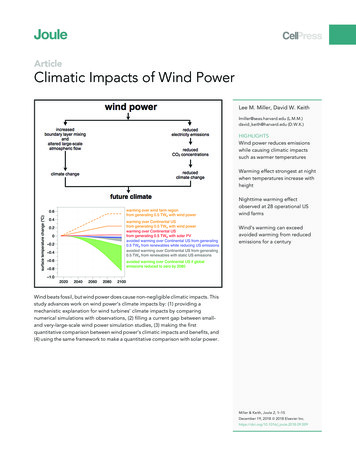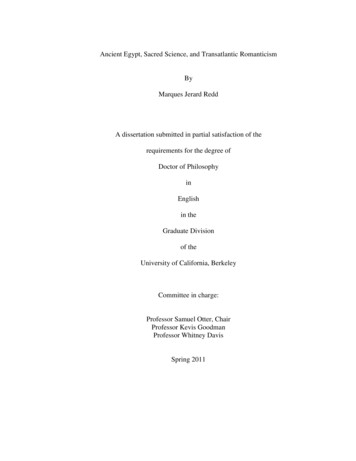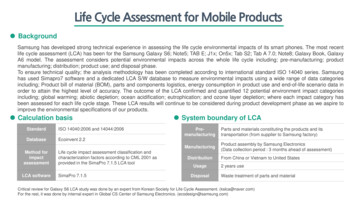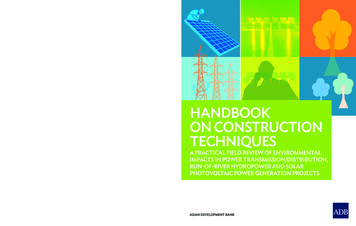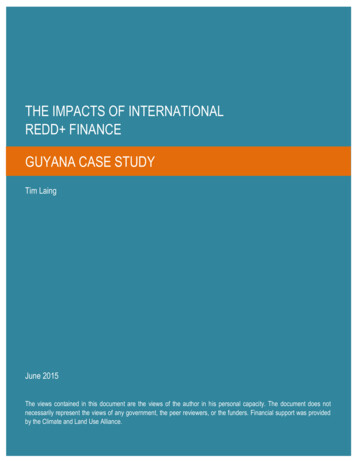
Transcription
THE IMPACTS OF INTERNATIONALREDD FINANCEGUYANA CASE STUDYTim LaingJune 2015The views contained in this document are the views of the author in his personal capacity. The document does notnecessarily represent the views of any government, the peer reviewers, or the funders. Financial support was providedby the Climate and Land Use Alliance.
The Impacts of International REDD Finance in GuyanaACRONYMSADFAmerindian Development FundCI-GConservation International-GuyanaEITIExtractive Industries Transparency InitiativeFCPFForest Carbon Partnership FacilityFLEGTForest Law Enforcement Governance and TradeGEAGuyana Energy AgencyGRIFGuyana REDD Investment FundIDBInter-American Development BankJCNJoint Concept NoteLCDSLow Carbon Development StrategyMOUMemorandum of UnderstandingMRVSMonitoring, Reporting and Verification SystemMSSCMulti-Stakeholder Steering CommitteeOCCOffice of Climate ChangePESPayment for Ecosystem ServicesPMOProject Management OfficePPP-CPeople’s Progressive Party - CivicREDD Reducing Emissions from Deforestation and Forest DegradationR-PPReadiness Preparation ProposalUNDPUnited Nations Development ProgrammeNote that throughout this report all dollar amounts are U.S. dollars.2
The Impacts of International REDD Finance in GuyanaCONTENTSACRONYMS . 2INTRODUCTION TO REDD FINANCE IN GUYANA . 4OBSERVED IMPACTS OF INTERNATIONAL REDD FINANCE . 7Environmental impacts . 7Economic impacts . 8Political impacts . 9Policy impacts . 10Stakeholder perception and participation . 11Impact on capacities . 12IMPACTS ON GUYANA’S FOREST SECTOR PATHWAY . 14FACTORS THAT AFFECT THE IMPACTS OF REDD FINANCE . 16CONCLUSIONS AND OUTLOOK . 19REFERENCES. 21Acknowledgments:The author would like to thank all the participants to the study including: Rene Edwards, Dane Gobin, MarianneJohansen, Shyam Nokta, John Palmer and Dr. David Singh. The participation of those thirty two participantsinterviewed for Dr. Laing’s PhD that has informed this study are also gratefully acknowledged.Information and comments received during interviews and peer review were considered and incorporated by theauthor at his discretion. All errors are the sole responsibility of the author.3
The Impacts of International REDD Finance in GuyanaINTRODUCTION TO REDD FINANCE IN GUYANAGuyana has embarked on one of the most ambitious national REDD programs in the world. The program is built onthe twin pillars of a Memorandum of Understanding (MOU) with Norway (Government of Guyana & Government ofNorway, 2009) which provides financial incentives to maintain a low deforestation level, and the Low-CarbonDevelopment Strategy (LCDS) (Government of Guyana, 2009) which outlines a vision for the future development ofthe country and highlights how revenue will be utilized. In addition Guyana is a participant in the Forest CarbonPartnership Facility (FCPF) and is developing REDD plans in accordance with this process. However the vast majorityof REDD finance, and thus the greatest source of impacts, has been from the MOU with Norway.The objective of the MOU is to “foster partnership between Guyana and Norway on issues of climate change,biodiversity and sustainable low carbon development”, and “the establishment of a framework for results-basedNorwegian financial support to Guyana’s REDD-plus efforts”.The MOU was accompanied by a Joint Concept Note (JCN) (Government of Guyana & Government of Norway, 2012)that established the framework for collaboration. The key points of the framework are: Norway will provide Guyana with finance of up to 250 million over the period 2010-2015; Finance will be channeled through a financial mechanism called the Guyana REDD Investment Fund (GRIF)managed by the World Bank. The fund is structured to allow contributions from a number of differentcontributors, although at present Norway is the only contributor; Finance will be paid post-delivery of results measured on two sets of indicators:oIndicators of Enabling Activities including the establishment of a strategic framework, a continuous multistakeholder consultation process, a strong governance environment and respect of the rights ofindigenous peoples and other local forest communities as regards to REDD ; and,oREDD Performance Indicators, a system of forest-based greenhouse gas emissions related indicators, tobe substituted with a Monitoring, Reporting and Verification System (MRVS) once established, thetimeframe of which is set out in a MRVS roadmap.To date Guyana has earned approximately 190 million from this arrangement, 70 million of which has beendeposited into the GRIF (The World Bank 2014), 5.8 million has been disbursed to the Guyana Forestry Commissionto assist with development of the MRVS, and 80 million has been directly transferred to the Inter-AmericanDevelopment Bank (IDB) for the government’s equity in the Amaila Falls Hydro-electric project. A further 40 millionis pending having been announced in May 2015.The finance that Guyana has earned from the MOU is to be used to implement Guyana’s LCDS and Guyana’s effortsin building capacity to improve overall REDD efforts. The LCDS:“ tries to do two things: assist in sustainable forest management and forest conservation, that would help us andthe international community address the global issue of climate change. But to deploy our forest in a mannerwhereby in doing this we can earn revenue that would help to move our economy along a low-carbon growthpath whereby we can try to at least have more efficiency in the way we utilize our natural resources and at thesame time ensure that we can safeguard and protect forest what it does is draws out some of the critical4
The Impacts of International REDD Finance in Guyanacomponents of [the National Development Strategy (NDS) and the National Competitiveness Strategy(NCS)] andintegrates them within the framework of REDD .”1The LCDS essentially takes the results-based REDD finance from the MOU and aims to transition Guyana’s economyon to a low-carbon pathway. The majority of funds are earmarked for projects that support this transition, such asthe intended hydropower project. As part of this process it also aims to build the infrastructure and enablingenvironment for Guyana’s REDD activities, along with funding projects to help implement actual REDD in thecountry. It therefore takes what is essentially results-based finance from Norway and channels it in a number ofdirections, mostly towards “green growth” projects, but also including support for REDD readiness andimplementation.2Projects under the LCDS are implemented jointly by Guyanese government agencies and partner entities (such as theIDB and the United Nations Development Programme (UNDP)) that serve as the mechanism for disbursement fromthe GRIF. Funding from the GRIF is used to both fund the projects and the preparation and administrative feescharged by these partner entities. Currently approximately 31 million has been spent out of the GRIF, about 50% ofthe amount received. Table 1 outlines the projects that have received money from the GRIF to date.Table 1: Projects implemented using GRIF finance (Source: World Bank, 2014)ProjectsDisbursement(US millions)5.94TitlePartner EntityInstitutional Strengthening ProjectIDBMicro and Small Enterprise Development Fund ProjectAmerindian Land Titling ProjectAmerindian Development Fund – Village Economy Development –Phase .20.060.9631.45FeesInstitutional Strengthening Project preparation feeMicro and Small Enterprise Development Fund Project preparation feeInstitutional Strengthening Project admin feeCunha Canal Rehabilitation project admin feesAmerindian Development Fund project admin feesAmerindian Land Titling Project Admin FeesAdministrativeBudgetsFY11-FY12 TrusteeFY13 TrusteeFY14 TrusteeSub-totalTotalIn addition Guyana is seeking other partners to provide finance to REDD activities and the GRIF.3 One source is theFCPF, through which Guyana is expected to receive a total of 3.6 million to implement activities outlined in itsReadiness Preparation Proposal (R-PP). However to date, Guyana has received no funds from the FCPF. ConservationInternational-Guyana (CI-G) has helped to harness finance (approximately 500,000) from the German DevelopmentBank (KfW) to assist the Guyana Forestry Commission (GFC) in developing and implementing its MRVS Roadmap,along with acting as a conduit for funds from Norway to both the OCC and the GFC. In addition, the Global Canopy1Nokta, S. cited in Laing (2014)Additionally adaptation projects also fall under the LCDS, showing Guyana’s holistic approach to REDD , climate change mitigation andadaptation.3This paragraph draws on material from Guyana’s entry on The REDD Desk available at: http://theredddesk.org/countries/guyana25
The Impacts of International REDD Finance in GuyanaProgramme and the Iwokrama International Centre for Rainforest Conservation and Development (IIC) has supportedthe development of Community MRV with funding from NORAD (approximately 700,000). IDB has also funded CI-G( 1.1 million) in the establishment of a project in the Rupununi area of the country designed to downscale the LCDSto a landscape level.This mix of different funding streams for REDD in Guyana, dominated by the MOU, has led to three categories ofimpacts: 1) Those relating to projects funded by the GRIF from the results-based finance under the MOU (forexample capacity development in GFC and OCC, and increased Amerindian Land titling); 2) Indirect impacts relatingto the receipt (and potential receipt) of results-based finance; 3) Impacts from finance received from other donorsfor REDD readiness and implementation. The impacts of all three of these categories are discussed in the followingsection.6
The Impacts of International REDD Finance in GuyanaOBSERVED IMPACTS OF INTERNATIONAL REDD FINANCEENVIRONMENTAL IMPACTSThe MRVS that has been established under the MOU with Norway and is used to assess the payment receivedannually by Guyana allows for an indication of the scale of the key environmental impact from the internationalREDD finance that the country has received. Historical rates of deforestation in Guyana are extremely low,measured at 0.01% per annum in the period 1990-2000, rising to 0.04% per annum between 2001 and 2005 beforefalling back to 0.02% in the period 2006-2009. Subsequent to the start of the MOU deforestation rates have risen to0.06% per annum in 2009-2010, falling back to 0.04% in 2010-2011, before doubling to 0.08% in 2011-2012 and thenfalling back to 0.07% in 2012-2013 (Guyana Forestry Commission & Indufor, 2012, 2013; Guyana ForestryCommission & Poyry Forest Industry, 2010). The rises in deforestation are primarily a result of small-scale miningactivity and related infrastructure. These statistics show that on the basis of the absolute numbers there is little signof a strong impact of the finance that Guyana has received upon current deforestation rates. It may be difficult todraw strong conclusions, however, due to the countervailing factor of the rise in international gold prices that hasprecipitated a mining boom in the country. At least one of the interviewees thought that deforestation has reducedcompared to a baseline without finance (although this seems counter-intuitive given the growth in the miningsector), whilst another argued strongly in the other direction. What is clear, however, is that international REDD finance has not yet been able to strongly influence the major driver of deforestation, small and medium scale goldmining.Beyond this headline figure there may have been other environmental impacts that cannot be so easily quantified,along with the potential for future changes in deforestation. Interviewees identified two potential areas ofenvironmental impact. The first is the raising of environmental awareness in the country. It was the generalperception of most of those questioned that the importance of environmental issues generally, and climate change inparticular, within and outside government, has increased as a result of Guyana’s pursuit of a low-carbondevelopment pathway. Although this may be above and beyond a direct impact as a result of dollars and centsreceived, it is the perception of many interviewees that Guyana would not have undertaken such a pathway withoutthe commitment of money on the table from the Norwegians. The placing of a value on Guyana’s forests inclusive ofthe carbon and the biodiversity was perceived by one interviewee to have helped drive the commitment of theGuyanese government to preserve Guyana’s forests. The establishment of the long-term planned Protected AreasSystem in 2011, and the National Land Use Plan in 2013 may be evidence of the growing importance of generalenvironmental issues in government decision-making as a result of the LCDS, although as neither was directly fundedby funding from the GRIF clear causality is difficult to determine.A negative environmental impact that an interviewee directly attributed to the receipt of international REDD finance is the increased emphasis in the LCDS on exploiting undeveloped non-forested lands for agriculturalproduction, such as is being undertaken through new agricultural concessions in the Intermediate Savannahs in theBerbice region of the country. The financial incentive placed on preserving every hectare of forest has changed thefocus of where agricultural production should be located away from forested areas to those areas like savannahswith little or no standing forest. However this raises a number of other environmental concerns such as the impacton water, soil and biodiversity and the indirect impact on the environment of the construction of the requiredinfrastructure to undertake commercial agriculture in these areas. This is particularly the case with the Rupununisavannahs where there are plans for large scale agriculture. It is felt that the use of fertilizers may affect the entirearea including the contiguous rainforest in the flooded periods of the year. The flooded area is also thought to be richin biodiversity.Longer term, interviewees did perceive possible impacts on the forest, and deforestation rates, as a result of theREDD finance that Guyana has received to date. It was the perception of a number of the interviewees that the7
The Impacts of International REDD Finance in Guyanaoriginal reference level4 has not required any change in government policy (with one interviewee going further tostate that the only impact has been an increase in destructive logging practice). However some interviewees thoughtthat this is likely to change with the Norwegians placing increasing pressure on the Guyanese government to takeaction on deforestation rates as a whole, and mining and forestry in particular through the adoption of internationalstandards such as the Extractive Industries Transparency Initiative (EITI) and Forest Law Enforcement Governanceand Trade (FLEGT) both of which the Government of Guyana is currently pursuing.Two further future impacts were also identified. The first relates to an increased mainstreaming of climate changeinto general development planning. As identified by interviewees the LCDS is more an economic development planthan a plan to directly reduce the pressure on forests. This integration of climate change aspects into widerdevelopment frameworks is also occurring through projects run outside the government such as CI-G’s project todownscale the LCDS to the Rupununi region. It was the perception of some of the interviewees that there isconsiderable potential for these types of projects to spread to other regions of the country, with associated potentialenvironmental impacts.The largest single project that has been earmarked to receive results-based finance under the MOU was the AmailaFalls Hydroelectric project. This 165 MW facility was slated to receive around 80 million of finance from the GRIF.However due to parliamentary opposition the project collapsed in 2013 with the withdrawal of the private sectorpartner. The current status of the project is unclear with the recent change in government. However, if the projectcontinues it is likely to lead to the largest point-source of environmental impacts from REDD finance—eitherpositive through avoided emissions from replacing the diesel used to currently generate electricity, or negativethrough land clearance and opening up the forest through roads and other infrastructure related to the project. Akey impact that has arisen from the project, even with its cancellation, has been the amending of legislation (theHydroelectricity Act) to provide for biodiversity offsets as part of the mitigation of environmental impacts fromhydro-electric projects. With this amendment in place, hydropower development will have to improve on thereduction of environmental impacts from projects, and residual impacts will have to paid for through offsets, such asconserving forest elsewhere, in order to maintain deforestation rates for the projects (and its offsets) below anestablished level. It also opens the door for other kind of offsets that may be used by, for example, the miningindustry. Options are under discussion for proposed large-scale projects such as the Guyana Goldfields Auroraoperation.ECONOMIC IMPACTSIn a similar vein to environmental impacts it is difficult to determine tangible economic impacts from Guyana’sreceipt of international REDD finance. This is due, in part, to the fact that although Guyana has earned in the regionof 190 million via the MOU from Norway only approximately 40 million of that has actually been spent, and eventhat is likely to be an overestimate as well over a quarter of that sum lies in the Micro and Small EnterpriseDevelopment Fund (MSEDF) and the Amerindian Development Fund (ADF), both of which have currently disbursedvery small amounts of funding. The largest share of spending from Guyana’s payment-for-results finance has gonetowards supporting government entities such as the GFC, the OCC and the Project Management Office (PMO).5 Theimpact of this finance is unclear although one interviewee made strong accusations that all this finance has achievedis increased wages and vehicles for the staff of these offices. Others commented that there had been some capacityimprovements, especially in the GFC.4The ‘combined reference level’ methodology is an average of Guyana’s mean 2000-2009 deforestation rate and the mean 2005-2009rate in developing countries with deforestation. This methodology results in a reference level of 0.275% for Guyana. Payments arecalculated by subtracting Guyana’s observed deforestation rate from the reference level and applying carbon-density proxies and aninterim carbon price of 5 per ton CO2e.5The PMO is described by the Head of the OCC in the following manner ‘The PMO is responsible for the implementation of the LCDSprojects, or the implementation process for that. So we have the GRIF which is the body that approves projects. Projects are submittedjointly by the implementing agency and a partner entity. The PMO would facilitate this process.’ (Nokta, S. cited in Laing 2014).8
The Impacts of International REDD Finance in GuyanaThe lack of economic impacts was ascribed partially to the fact that disbursement has been slow, with much earnedmoney still to be disbursed. There were few economic impacts (either positive or negative) identified by intervieweesin land-use sectors, partially due to the lack of strong incentives created thus far for change, with a greater focus puton transitioning the economy as a whole. Future potential economic impacts were identified however, related torenewable energy and green businesses.A key area is the renewed interest and pursuit of renewable energy in the country, for example through the AmailaFalls project. In addition there has been renewed interest and disbursement of solar panels to remote communities(although there have been allegations of political favoritism in their distribution) and interest in wind energy. Thesepotentially have long-term economic benefits for the country as it currently imports all of its fossil fuels that it uses togenerate the vast majority of its expensive energy. However many of these potential economic benefits are notionalwith the stalling of the Amaila project. If the Amaila project continues it could lead to further economic impactsthrough reduced electricity prices, although this has been disputed (Demerara Waves, 2013).Another area identified as a potential future economic impact is through the promotion of low-carbon, greenbusinesses. This is a stated aim of the LCDS and key projects funded by the GRIF directly, and related to the LCDSmore generally, have this as their aim. The establishment of a MSEDF was the second project under the GRIF toreceive finance. CI-G’s Rupununi project also has a key component of a revolving fund, hosted by Guyana Bank ofTrade and Industry, to support low-carbon, green businesses in the region. The 290,000 Rupununi Innovation Fundaims to provide financing and technical support for local and community-based agriculture and tourism enterprisesto enable their participation in, and support of, the LCDS.Despite this potential for future positive economic impacts from REDD finance, it was the view of more than oneinterviewee that in fact the economy seems to have developed away from a low-carbon trajectory with none of therecent economic development related to the receipt of REDD finance. Instead it has resulted from extractiveindustries, through increased mining and logging, with the future potential for even more growth in the sectorthrough the recent discovery of oil offshore (Reuters, 2015).POLITICAL IMPACTSREDD has managed to reach the very top of the political agenda in Guyana. The policy was initiated and driven bythe then President Bharrat Jagdeo, who has since become a major international figure on REDD . It was thecornerstone of the political agenda of the ruling People’s Progressive Party-Civic (PPP-C) coalition between 2009 and2011, being driven by President Jagdeo and managed out of the twin offices of the OCC and the PMO, both housed(institutionally and physically) within the Office of the President. Again, although it is difficult to define a fully causallink, the lack of a REDD agenda in the country (and indeed a strong environmental agenda) prior to the agreementwith Norway seems to be evidence that international REDD finance has been crucial in creating this initial politicalsupport at the highest level.The ownership of the process by President Jagdeo allowed REDD to move very quickly to the top of the politicalagenda in the country. The LCDS was also tabled twice in the Parliament of Guyana with a Motion for support passedin 2009. REDD therefore became part of the political mainstream in the country and part of the general discourse. Italso helped to catalyze discussion of environmental issues more generally, leading to associated impacts, such as thelong-awaited establishment of the country’s Protected Areas System.Despite this initial impact, however, it was the view of more than one interviewee that this political momentum hadnot been maintained. REDD policy (like much of government policy generally) was tightly controlled by PresidentJagdeo (Laing 2014). This centralized control, it was perceived, led to a lack of political buy-in for the policy from boththe opposition but also from the rest of the ruling PPP-C coalition. This is evidenced in some part by the lack ofattention given to REDD by President Donald Ramotar, who held power from 2011 to May 2015. The one exception9
The Impacts of International REDD Finance in Guyanais the formation of the new Ministry for Natural Resources and the Environment (MNRE) in 2012 that broughttogether the key resource management agencies under one banner. One interviewee expressed the view thatPresident Jagdeo thought of REDD finance as ‘my money’ and this perception of such a close ownership of thefinance and the process of how it will be spent by a relatively small group of actors may also have led to a lack ofwider political impact (Laing 2014).The lack of attention from President Ramotar led to the perception that REDD may have been de-prioritized. Theslowness of REDD finance actually hitting the ground at this point may also have contributed to this drop-off inpolitical impact (Laing 2014). The lack of wide buy-in to REDD coupled with the slowness of financial disbursal mayhave also led to the lack of attention placed by the new APNU-AFC government, who just took over in May 2015, onREDD and the LCDS. At this stage it is unclear the level of importance that the new coalition will place on REDD ,whether they plan to reform or revise the LCDS, or even where ultimate responsibility for REDD and the LCDS nowlies (Stabroek News 2015). It was, however, the perception of the interviewees that the substantial amount of REDD finance that Guyana has earned but has remained unspent (approximately 150 million) could serve as an importantcarrot, placing REDD back on the political agenda. The general lack of noise regarding the LCDS since the electionraises this into question—although, as another interviewee put it, REDD might provide ‘too much money to throwaway’. It is also unclear as to what Norway’s position will be as the 5-year agreement ends shortly.POLICY IMPACTSGuyana has undertaken a unique approach to REDD policy, and utilization of REDD finance. Rather than targetforest-related sectors specifically it has instead committed to using finance received from results-based REDD totransition the entire economy on to a low carbon pathway. Through projects such as Amaila Falls it hascommunicated a potential ‘double-dividend’ of REDD finance—maintaining a low deforestation rate and Guyana’sstanding forests, and eliminating greenhouse gas emissions from sectors such as energy. Its holistic LCDS thus hasaims far beyond mere REDD and aims at total economic transformation.In order to help this transformation Guyana has started to implement a number of new policies, either directly orindirectly as a result of REDD finance. Norway has included requirements for the country to sign up to EITI andFLEGT in order to access finance as part of the revised JCN. In addition a new National Forest Plan was established in2011 along with a National Forest Policy Statement designed to encourage best practice in the sector. In 2013 a newNational Land Use Plan was implemented to “provide a strategic framework to guide land development in Guyana”(Guyana Lands and Surveys Commission 2013). The Protected Areas Act was passed in 2011, establishing a ProtectedAreas System. The Act frames the establishment of Protected Areas as a national response to mitigate climate changethrough maintenance of ecosystems—thus recognizing the direct connection between biodiversity conversation andclimate change mitigation. Although these latter policies were not directly funded by REDD finance they did moveforward rapidly following the establishment of the LCDS. Perhaps more closely related to the receipt of finance(although again not directly funded) was the drafting of new codes of practices for the mining sector (the key driverof deforestation), including a component on Mining Reclamation and Closure, covering how mine sites could becorrectly closed down to allow restoration of the environment to occur. The most directly attributable policy impactfrom REDD finance was the increase in titling, demarcation and extension of Amerindian Lands. A project has beenfunded by the GRIF to extend existing processes in this area, under the Amerindian Act of 2006. The full titling anddemarcation of Amerindian Land is a key precursor to moving toward a proposed “opt-in mechanism” that wouldallow Amerindian communities and protected areas to directly participate in REDD by including their forested landsunder the provisions of the MOU with Norway.Despite these lofty goals there was a general sense of skepticism across the majority of interviewees about howmuch has actually been achieved in terms of clear and demonstrable policy impacts on the ground. It was unclear tosome interviewees about what had actually changed as a result of REDD finance. Although there had been muchdiscussion of improved regulation and impro
The finance that Guyana has earned from the MOU is to be used to implement Guyanas LDS and Guyanas efforts in building capacity to improve overall REDD efforts. The LCDS: tries to do


